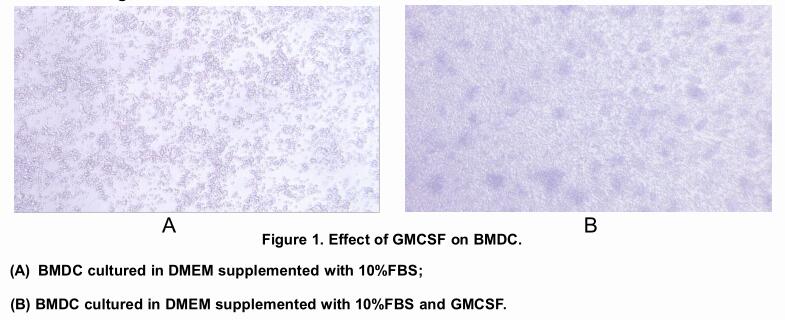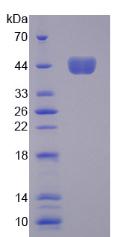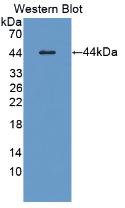Active Colony Stimulating Factor 2, Granulocyte Macrophage (GM-CSF) 

CSF2; GMCSF; Sargramostim; Molgramostin; Granulocyte-Macrophage Colony Stimulating Factor
- UOM
- FOB US$ 272.00 US$ 680.00 US$ 1,360.00 US$ 4,080.00 US$ 10,200.00
- Quantity
Overview
Properties
- Product No.APA045Mu01
- Organism SpeciesMus musculus (Mouse) Same name, Different species.
- ApplicationsCell culture; Activity Assays.
Research use only - DownloadInstruction Manual
- CategoryCytokineHematology
- Buffer Formulation20mM Tris, 150mM NaCl, pH8.0, containing 1mM EDTA, 1mM DTT, 0.01% SKL, 5% Trehalose and Proclin300.
- Traits Freeze-dried powder, Purity > 90%
- Isoelectric Point5.9
Sign into your account
Share a new citation as an author
Upload your experimental result
Review

Contact us
Please fill in the blank.
Activity test

Measured in a cell proliferation assay using mouse BMDC (bone marrow derived dendritic cells). The ED50 (median effective dose) for this effect is less than 0.25 ng/mL.
In-house data of APA045Mu01 used in cellular experiment:
Six-eight weeks old Balb/c mice were used for BMDC. At first, mouse femur and tibia were taken out, and then bone marrow was washed out with serum-free RPMI 1640 medium, followed by centrifugation at 1200RPM for 5min (4oC). ACK buffer was added to get rid of red blood cells, and then, centrifuged at 1200RPM for 5min (4oC). Cell pellets were collected and re-suspended, the cells were cultured in DMEM medium supplemented with 10% FBS, or DMEM medium supplemented with 10% FBS and GMCSF (APA045Mu01) at 37oC with 5% CO2 in thermostatic incubator. Three days later, cells were observed by microscope, and the result is shown in Figure 1.
Usage
Reconstitute in 20mM Tris, 150mM NaCl (pH8.0) to a concentration of 0.1-1.0 mg/mL. Do not vortex.
Storage
Avoid repeated freeze/thaw cycles. Store at 2-8°C for one month. Aliquot and store at -80°C for 12 months.
Stability
The thermal stability is described by the loss rate. The loss rate was determined by accelerated thermal degradation test, that is, incubate the protein at 37°C for 48h, and no obvious degradation and precipitation were observed. The loss rate is less than 5% within the expiration date under appropriate storage condition.
Increment services
-
 BCA Protein Quantification Kit
BCA Protein Quantification Kit
-
 Molecular Mass Marker for Protein
Molecular Mass Marker for Protein
-
 Monoclonal Antibody Customized Service
Monoclonal Antibody Customized Service
-
 Polyclonal Antibody Customized Service
Polyclonal Antibody Customized Service
-
 Protein Activity Test Experiment Service
Protein Activity Test Experiment Service
-
 Electrophoretic Mobility Shift Assay (EMSA) Experiment Service
Electrophoretic Mobility Shift Assay (EMSA) Experiment Service
-
 Buffer
Buffer
-
 Lentivirus Packaging Experiment Service
Lentivirus Packaging Experiment Service
-
 Adenovirus Packaging Experiment Service
Adenovirus Packaging Experiment Service
-
 Real Time PCR Experimental Service
Real Time PCR Experimental Service
-
 Spike RBD Protein (S-RBD)
Spike RBD Protein (S-RBD)
-
 Protein G
Protein G
-
 Protein A
Protein A
Citations
- Effects of 900-MHz Microwave Radiation on γ-Ray-Induced Damage to Mouse Hematopoietic SystemPubMed: 20391130
- Safety and efficacy of the peptide-based therapeutic vaccine for HIV-1, Vacc-4×: a phase 2 randomised, double-blind, placebo-controlled trialPubmed:24525316
- Genetic and immunogenicity analysis of porcine circovirus type 2 strains isolated in central ChinaPubmed:29305646
- Activated Macrophages of Monocytic Origin Predominantly Express Proinflammatory Cytokine Genes, Whereas Kupffer Cells Predominantly Express Anti …
- Quantitative and Qualitative Characterization of Phagocytic Activity of Macrophages of Bone Marrow and Fetal OriginPubmed: 31183654
- The regulatory role of SFRP5/WNT5A axis in allergic rhinitis through inhibiting JNK pathway activation and lowering mucin generation in human nasal?¡33285209
- Co-delivery of PSMA antigen epitope and mGM-CSF with a cholera toxin-like chimeric protein suppressed prostate tumor growth via activating dendritic cells and?¡33612342








